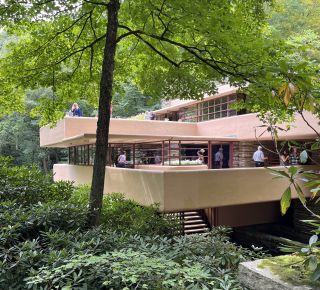KEY POINTS-
- We often allow structures to limit how we think and resilience becomes stunted.
- Formal structures don't have to be rigid. Creative solutions exist.
- Resilient organizations are ones where knowledge can flow to where it is needed.
- Sharing knowledge is always win-win.

I recently visited one of Frank Lloyd Wright’s houses called Falling Water. It was a magical trip. Even though I had been there before, the docent who led us through the house called forth so much more of what Wright had done in the house to make it a hospitable place — one that was hospitable to nature as well as the occupants of the house. If you have ever been there, you know what I mean. If you haven’t been there, put it on your bucket list.
While later perusing the gift shop, I came across the book, 50 Lessons to Learn from Frank Lloyd Wright by Aaron Betsky and Gideon Fink Shapiro. I immediately bought the book, as I have learned long ago that lessons from a genius in one arena are often applicable in another. The brilliance expressed in one arena expands understanding in another. Reading the book, my belief was confirmed.
Buildings do not have to be made up of squares. Betsky and Shapiro write, “Break that container and the world outside and in yourself opens up.” Break the box is the first lesson.
Boxes Prevent the Flow of Knowledge
Resilience depends on having knowledge. Highly resilient individuals have in-depth knowledge. In resilient organizations, necessary knowledge is available where and when it is needed. What comes to mind in organizations is how their structures, described only on paper, prevent the flow of information and knowledge between and among the "boxes." If resilience depends on knowledge, how do you open the flow of knowledge?
Resilient Leaders Create Flows of Knowledge
In our organizations, the word silo is often used where the implied lines between units become unbreakable barriers. As a resilient leader, imagining ways in which knowledge can flow through or around the barriers supports creativity for tackling problems — expected as well as the unexpected. One way to permit this is to create an event where staff from both sides of that barrier get a chance to talk with one another about their successes. Why successes? Everyone loves to talk about a success. It doesn’t feel difficult to do, nor threatening. Then, as the stories come flooding out, everyone begins to see and feel more connected. When you feel connected, even more information and knowledge flows.
If you are not in a position to create such an event, find a way to invite someone from that other unit (that other "box") to come and talk about a recent project win or an unexpected solution found when a situation arose. Don’t worry about making sure that you can send one of your staff over to that silo. The value has already been achieved. The visiting presenter has had the opportunity to hear how your staff have solved similar challenges. The shared knowledge stimulates conversation as your staff explore what it means to the unit. Not to mention that the visitor feels proud and remembers what he or she learned in the telling and listening as well. It’s win-win.
There are 49 more lessons from Frank Lloyd Wright. I’ll try another next time.


